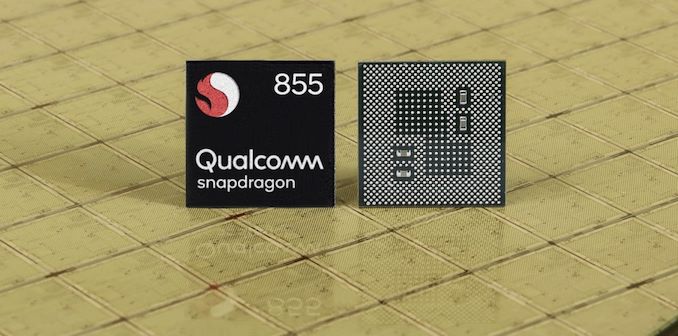The Snapdragon 855 Performance Preview: Setting the Stage for Flagship Android 2019
by Andrei Frumusanu on January 15, 2019 8:00 AM EST- Posted in
- Mobile
- Qualcomm
- Smartphones
- SoCs
- 7nm
- Snapdragon 855
Final Thoughts
2018 has been a very successful year for Qualcomm and the Snapdragon 845. The company had provided an extremely solid and well-rounded SoC for device vendors to build their flagship devices on- and by the looks of it the Snapdragon 855 continues this trend.
I’ve been a bit sceptical about the merits of Qualcomm’s 1+3 CPU configuration, however after seeing the preliminary performance and power efficiency figures of the new prime core on the new chipset, I’m not nearly as concerned. We reserve any final verdict for when we will have tested final commercial devices, as that’s where in the end we’ll also see the efficiency effect of the non-prime cores, and how they’ll position themselves against the competition.
Performance wise, the Snapdragon 855 is a bit odd. In steady-state workloads like SPEC the chipset is seemingly performing very well and matches or exceeds the new Kirin 980. Here Qualcomm’s changes to the CPU microarchitecture might even actually be visible in the test results, which is a nice feat. Unfortunately the memory subsystem still seems to include some of DRAM latency regressions that we also saw in the Snapdragon 845, both which are due to Qualcomm’s system level cache.
Real-world performance, while still excellent, doesn’t quite manage to reach my expectations I had for the chipset. Here for whatever reason, the chip’s improvements are not nearly as pronounced as in the more synthetic tests. Again the odd thing is that the Kirin 980 still manages to beat the Snapdragon 855 in near most of these workloads. Qualcomm had reasoned that the microarchitectural changes to the CPU were meant to help web browser performance, yet it’s here where the chip slightly lags behind the competition – I do wonder if this is a case of the CPU again being limited by either Qualcomm’s choice of more conservative caches or due to the latency penalty of the system cache.
Although the performance shown today is exemplary, it still does look maybe a little rough around the edges in some of our system performance tests – here maybe Qualcomm will be able to investigate and further improve things until we actually see commercial devices.
Whether the system performance will be improved in final devices or not, what is clear though is that power efficiency looks outstanding. Qualcomm had me worried as the PR teams had avoided talking about efficiency during the chipset’s launch, but the results today (even if they’ll need to be verified), look very promising and should result in notable battery life improvements in 2019’s devices.
On the GPU side of things, Qualcomm’s more muted performance projections of 20% were because the company has again focused a good part of the process improvements into bringing the overall power back down from the usually higher levels that we saw on the Snapdragon 845.
Overall – the Snapdragon 855 looks to be another extremely well executed SoC from Qualcomm, and I’m looking forward to validating the results and testing out the first commercial devices once they become available.











132 Comments
View All Comments
SirMaster - Sunday, January 20, 2019 - link
Very untrue.Are you saying that somehow the iOS vs. Android OS integration with the CPU has an affect onb geekbench benchmarks?
That makes no sense. Geekbench is a purely mathematical benchmark and the OS should have no affect on its results other than how it power manages the SoC during the benchmark.
joms_us - Tuesday, January 15, 2019 - link
Take a look at the last 2-3 years speed (real-world apps, productivity and games) tests, iPhone with its fastest SoC on imaginary paper lags behind the competition.29a - Tuesday, January 15, 2019 - link
I'd be bitter too if I had to use and Android phone.cwolf78 - Tuesday, January 15, 2019 - link
Ditching my iPhone for a Pixel was a smart move. OS is light years ahead.techconc - Tuesday, January 15, 2019 - link
Examples of your claim? Android devices can't even do something like Fortnite at 60fps and you claim Android devices are faster? Pretty funny.dudedud - Tuesday, January 15, 2019 - link
He meant those "speed test" that consist on opening apps with your fingers trying to match the touch... you know, measuring the storage and ram and not so much the SoC's capabilities...Also, iOS and android diverge in animation speed, sometimes assets and most of the time longer screen logos (or inexistent on android).
A total waste of time.
joms_us - Wednesday, January 16, 2019 - link
As if you can use the SoC alone, you know computer don't just run with processor alone so yeah in actual usage A12 inside.iPhone is just as fast if not slower than competition.joms_us - Wednesday, January 16, 2019 - link
It's a game-related issue (I think there is an FPS limiter set to 30fps on Android version of Fortnite) and most of them are optimized for iOS, and FWIW, a phone with mediocre resolution will have fast FPS on games.PeachNCream - Tuesday, January 15, 2019 - link
Ironchef, comments like that are just going to trigger a bunch of brand loyalty arguments where people banter over insignificant points and ultimately change no one's opinion about which piece of consumer electronics gets them feeling warm and gooey inside.techconc - Tuesday, January 15, 2019 - link
The short answer is no, it's unlikely anyone will catch Apple on ARM. ARM reference designs are several generations behind Apple and when companies like Samsung attempt their own design like they have with recent Exynos, it's clear that not only can't they match performance, but efficiency is horrible by comparison. Apple has a world class team that is likely the best design team on the planet right now.